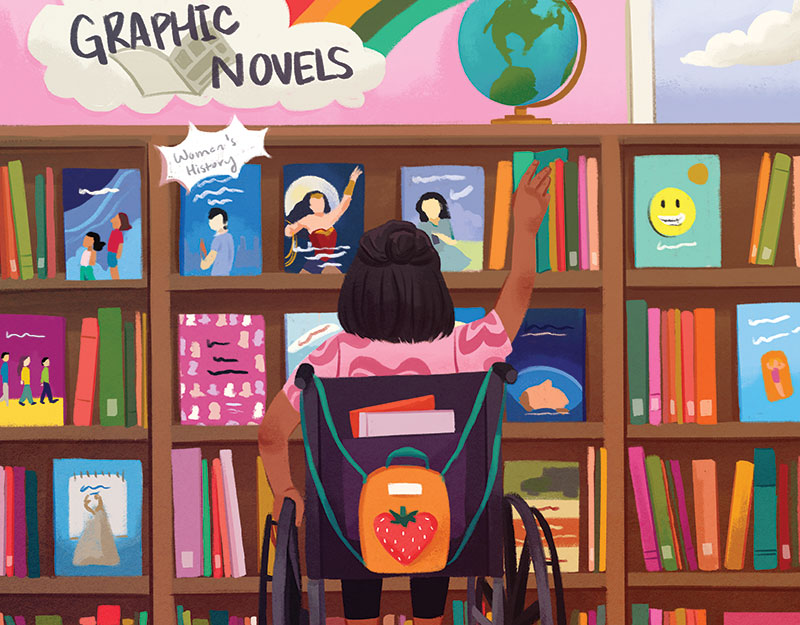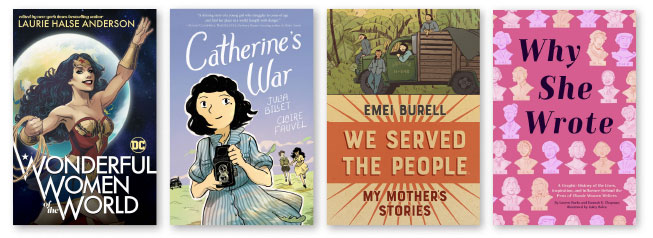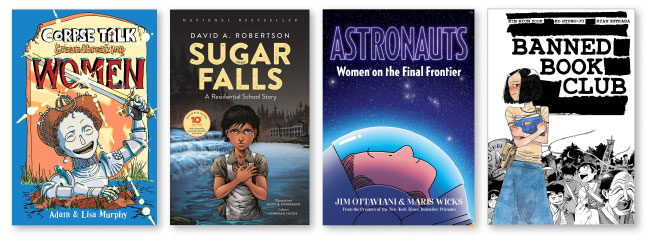A Woman’s Place Is in a Graphic Novel: Outstanding Works for Young Readers Center Women in History
12 stories for grades 3 and up spotlight Queen Hatshepsut, Josephine Baker, Mary Shelley, and more remarkable women.
 |
Illustration by Carina Guevara |
Historian Rebecca Hall begins and ends her graphic novel Wake (S. & S., 2021) with a revolt on an 18th-century slave ship. In between those two points, much of the book is set in the present day, with Hall as the lead character, searching through archives and legal records to uncover the role that women played in leading uprisings of enslaved people.
Graphic novels like Hall’s are a powerful tool for restoring women to their rightful place in history and uplifting the voices and deeds of women who have been forgotten, ignored, or deliberately suppressed. The visual medium allows creators to vividly depict their subjects and their surroundings, providing at a glance what a prose book would take paragraphs to describe. Freed of the necessity to literally spell everything out, graphic novelists can focus on the most compelling aspect of these women: their stories.
This is the alchemy of graphic novels: Drawing on primary sources, creators can turn dry facts into compelling narrative. In Wake, Hall discovers that the more women there were among the captives on a slave ship, the more likely it was that those captives would revolt. Hall uses these statistics as a starting point, drawing on the history of the region where the slaves were taken as well as the common practices aboard slave ships to depict the action on board.
Where Hall goes deep, Mikki Kendall and A. D’Amico go wide. Their Amazons, Abolitionists, and Activists (Ten Speed, 2019) depicts the accomplishments of hundreds of women across thousands of years, weaving them together into a roughly chronological historical tapestry. In their short accounts, Kendall and D’Amico present each woman in the context of her society, and they do not shy away from portraying their faults as well as their virtues, whether that be the cruelty of a queen or the racism of many American and English suffragists.
Another genre of graphic novels is also important to women’s history: memoir. The women who record their experiences, or those of their mothers and grandmothers, ensure that these stories will be available to future historians and that the picture they see of our times will be richer and fuller than those painted of the past. Whether peasants or princesses, women are an integral part of every society, and graphic novels offer an immersive way to share their experiences.
Here’s a list of graphic novels that record the lives and deeds of women, from the queens of the ancient world to a Native American child forced to attend a residential school. Some are full stories, while others are quick sketches, but all will leave readers with a more accurate sense of the societies of the past and the part women played in them.

Suggested Reading
Anderson, Laurie Halse, ed. Wonderful Women of the World. illus. by various. DC Comics. 2021
Gr 7 Up –Various creative teams offer short comics on women achievers, from Swedish activist Greta Thunberg to U.S. Supreme Court Justice Ruth Bader Ginsburg to Malaysian scientist Khatijah Mohamad Yusoff, whose research on viruses has led to promising treatments for cancer, to early Black American trans pioneer Marsha P. Johnson. Each chapter uses a different art style and storytelling technique, and some of the creators include themselves in the stories and illustrate how the subjects affected their own lives.
Billet, Julia. Catherine’s War. illus. by Claire Fauvel. HarperAlley. 2020.
Gr 3-7 –Rachel Cohen is forced to change her name to Catherine Colin and leave the safety of her boarding school when the Nazis occupy France. As she moves from place to place, Catherine records her journey with her camera, giving her and the reader a new perspective on everything she sees. In this poignant work, Billet drew on her mother’s experiences as a child in hiding in France during World War II.
Burrell, Emei. We Served the People. illus. by author. Archaia. 2020.
Gr 9 Up–Burrell’s mother, Yuan, grew up in China and was sent to the countryside as a teenager during the Cultural Revolution. Like many Chinese people of her generation, Yuan was forced to leave school and her family in Beijing and travel to a remote part of the country; she wound up working on a rubber plantation and driving a truck for 10 years before returning to Beijing. There she had to contend with the realities of post-Mao China, studying to make up for the years of lost education while working at a job with supervisors who dismissed her ambitions. Eventually, through a combination of luck and hard work, she was able to escape her stifling job and complete her studies; the book ends with her learning that she has received her student visa and, in her mid-30s, preparing to move to Sweden.
Chapman, Hannah K., and Lauren Burke. Why She Wrote: A Graphic History of the Lives, Inspiration, and Influence Behind the Pens of Classic Women Writers. illus. by Kaley Bales. Chronicle. 2021.
Gr 9 Up –The 18 short biographies in this book are arranged thematically, with the authors organized into groups of three according to their accomplishments or genres. We see Jane Austen being bored to tears when her family moves to Bath, England; Mary Shelley enduring the personal struggles that inspired her to write Frankenstein; and the diarist Anne Lister living an openly queer life in the 19th century. The tone is light and the stories entertaining, but the underlying theme is often quite serious.

Ha, Robin. Almost American Girl: An Illustrated Memoir. illus. by author. Balzer + Bray. 2020.
Gr 8 Up –Ha was 14 when she and her mother traveled to Huntsville, AL, from South Korea for what she thought was just a vacation. Just a few days later, her mother announced that she was going to marry the man they were visiting and that they would be staying in Huntsville for good. With very little English and a stepfamily that wasn’t particularly welcoming, Ha had a tough time in school—an experience with which many readers will readily relate. As the story goes on, she reveals the discrimination her mother faced as a single mother in South Korea. When Ha returns to South Korea as a young adult, she sees her old school friends forsaking careers for marriage and getting plastic surgery to meet society’s expectations. She comes to understand why her mother made the difficult choice that she did.
Hall, Rebecca. Wake: The Hidden History of Women-Led Slave Revolts. illus. by Hugo Martínez. S. & S. 2021
Gr 8 Up –Hall, a historian, is fascinated by the enslaved women who plotted and led revolts, but the information she wants to find is often buried deep in archives whose custodians have little interest in helping her. She depicts her own experiences as she follows the tiniest of clues, a chance reference or a name in a court filing, to tease out more information about these women. When that fails, she sometimes fills in the gaps with her own imagination, informed by her historical knowledge. The book is a blend of memoir and historical exposition, conveying the excitement and frustration of historical research as well as the disrespect that she encounters as a Black woman on several occasions: When she tries to access the archives of Lloyds of London, which built its business by insuring slave ships, she is turned away with a sneer. Hall doesn’t flinch from showing her own visceral reactions to her research and depicts herself becoming overwhelmed and deliberately stepping away at times. The rough, black-and-white art suits the subject matter. It is particularly powerful when Hall is walking through New York and images of those who walked the same streets hundreds of years before are seen in windows and puddles.
Kendall, Mikki. Amazons, Abolitionists, and Activists: A Graphic History of Women’s Fight for Their Rights. illus. by A. D’Amico. Ten Speed. 2019
Gr 7 Up –Kendall and D’Amico start out by looking at the status of women in several past societies and then moving on to the accomplishments of a host of remarkable individuals. The scope of the book is global, and while most of the bios are just a page or two long, the authors provide context as they list the chief accomplishments of each woman. The book is structured as an immersive virtual reality class, so the students appear to be walking through the historical scenes and can ask questions, sometimes pointed ones.
Kiehner, Elizabeth, and Kara Coyle. Good Girls Don’t Make History. illus. by Micaela Dawn. Wide-Eyed Editions. 2021
Gr 6-9 –This graphic novel is a fairly straightforward time line of the women’s suffrage movement in the United States, beginning in the 1840s, shortly before the Seneca Falls Convention, and running through decades of unsuccessful campaigns to the passage of the 19th Amendment in 1920. The narrative focuses on white women, and while it does depict a few Black women in the movement, it omits the overt racism of many white suffragists. A framing tale set in the present day shows groups of women and girls discussing voting, then flashing back to the events of the past.

Murphy, Adam & Lisa Murphy. Corpse Talk: Groundbreaking Women. illus. by Adam Murphy. DK. 2020
Gr 4-7 –The Murphys intend the word groundbreaking in the title to be taken literally: This book is set up as a mock talk show in which coauthor Adam Murphy interviews reanimated corpses. The 18 women profiled stretch from Queen Hatshepsut to Josephine Baker, with each one getting four pages of snappy dialogue, in which they describe their lives and dispel misconceptions, followed by a spread about one of their major accomplishments.
Ottaviani, Jim. Astronauts: Women on the Final Frontier. illus. by Maris Wicks. First Second. 2020.
Gr 4-7 –Ottaviani and Wicks tell the story of women in space through the experiences of cosmonaut Valentina Tereshkova and American astronaut Mary Cleave. While the Soviets saw women cosmonauts as a propaganda triumph, the Americans barred women from the space program. This book details the physical and political challenges that women on both sides faced: their campaign to be included, their introduction to space travel (on the American side), and their experiences preparing for and then traveling to outer space.
Robertson, David A. Sugar Falls: A Residential School Story. illus. by Scott B. Henderson & Donovan Yaciuk. HighWater. 2021.
Gr 9 Up –Betty Ross, Elder of the Cross Lake First Nation, describes her experiences in this graphic novel, which portrays her as a storyteller speaking to contemporary teenagers. She was taken from her parents and brought to a residential school, where she was physically and sexually abused. Her father’s words, reminding her of the oneness of all humanity, gave her strength. She later became an expert in her native language, Cree, which was forbidden at the school.
Sook, Kim Hyun, & Ryan Estrada. Banned Book Club. illus. by Hyung-Ju Ko. Iron Circus. 2020.
Gr 7 Up –Sook, who is South Korean, began college in 1983, against her mother’s wishes, and soon became involved with a group of students who were engaging in dangerous activism: reading and sharing books that were banned by the military regime that ruled the country at the time. Her companions also opened her eyes to the truth of South Korea’s recent history and the realization that they were living under a dictatorship. The creators deftly mix the grim realities of 1980s South Korea with the usual activities of college students—friendships, romance, classes, and, in Sook’s case, embarrassment when her mother makes a scene—so the book feels grounded and relatable, despite the seriousness of the situation.
Brigid Alverson founded the “Good Comics for Kids” blog (slj.com/GoodComicsforKids).
RELATED
The job outlook in 2030: Librarians will be in demand
The job outlook in 2030: Librarians will be in demand
ALREADY A SUBSCRIBER? LOG IN
We are currently offering this content for free. Sign up now to activate your personal profile, where you can save articles for future viewing





Add Comment :-
Be the first reader to comment.
Comment Policy:
Comment should not be empty !!!